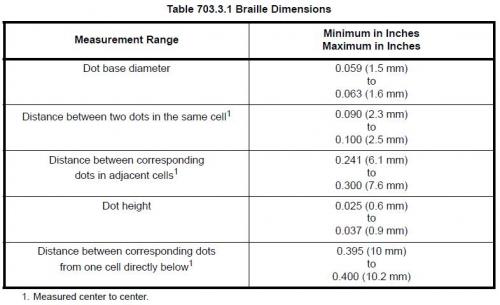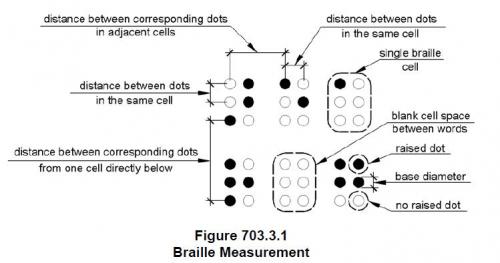The ADA Room Identification Sign
We know how exciting it is when you spend months waiting with great anticipation as a new building takes shape. You eagerly check every day to see if the building is complete and then the day finally comes that the building opens. You move quickly toward the front door of the building and as you reach for the handle your breathing becomes more rapid as the excitement builds from somewhere deep inside of you. The door swings open with ease on its brand-new hinges and your eyes quickly scan the room until you finally spot what it is you have been waiting so many months to see. As you approach, your excitement increases with every step until you finally reach your destination. You stand in front of it and slowly exhale as you stare at it and marvel in its beautiful design, you are amazed how such a simple thing can be so interactive, so informative and so necessary. With a trembling hand you extend your index finger moving closer and closer until you finally touch it! A smile slowly spreads across your face as you finally feel what you have been waiting so long to feel, the ADA sign!
Okay so that story may be a bit of a stretch for probably anyone but there is some truth to it. The ADA sign is informative, interactive, and necessary and can be beautiful in design. I know the questions that are burning in your mind right now are, what does an ADA sign entail and what makes an ADA sign necessary? Well since you have read this far you may as well keep reading and I will answer those questions for you and I promise that the rest of this blog will be more truthful than the story above.
The ADA Sign
Unless you have never been in a building you know what an ADA room sign looks like. We see them in office buildings, schools, hospitals, etc. What you may not know is that the sign is required to be there and there are laws that are written by the Department of Justice and these laws govern how the sign is constructed. For the purpose of this blog when we talk about an ADA sign and, we will be talking about a general room sign such as a Conference Room. We will cover other types of ADA signs in future blogs.
The ADA sign must have at least two things to be compliant, raised text and braille. The raised text not only works as a tactile character for the blind, it also serves as visual characters for the sighted. The braille however is there for the blind. Now if it was only as simple as putting some text and some braille on a sign, I wouldn't need to write this and could have spent this time doing something more fun like fishing or hiking but there is more to it than that so lets break it all down.
Like any piece of art, you must start with a working surface. This can be called many things like the faceplate, the panel, the blank and I am sure there are plenty of others but for now we will stick with the faceplate. The faceplate can be made up of many different types of materials, just use your imagination but acrylic seems to be the most popular substrate. The size of the faceplate will be determined by the amount of text that will be going on the sign, but many sign companies try to keep similar signs all the same size for consistency such as having all of the patient room signs in a hospital the same size even though some have 3 numbers and some may have 4 numbers. The thickness of the faceplate can also vary greatly depending on the design intent of the sign. ADA law does not make any requirements for the faceplate, only what goes on the faceplate and that it should contrast in color with the text but you do want to make sure it is thick enough to be sturdy on the wall. We typically will not go thinner than 1/8” thick.
The first thing anyone notices about an ADA sign is the raised text or raised tactile characters which is what we all read when we see the sign. The raised tactile characters must stick up from the surface at least 1/32" but can be thicker if you want. The raised tactile characters should contrast well with the background such as dark letters on a light background or light letters on a dark background so they are easy to read by the sighted. The raised tactile letters/numbers have to be at least 5/8" in height and a maximum height of 2" and must all be uppercase. The font that is used on the sign must be a sans serif font and cannot be italicized, script, elegant or any other unusual form. The stroke width of the font is also regulated where the letter "O" must be 55% - 110% of the height of the letter "I". You can see these laws by clicking here.
Now there is one exception to the minimum 5/8” height of the letters. If you have both visual characters and raised tactile characters your raised tactile characters can be 1/2" tall instead of 5/8” tall. The cool thing about this exception to the law is it allows you to have an elegant font for the sighted and then your raised tactile characters can blend into the background. This allows you to make up some really neat designs like the one pictured below. You can see the law for this exception here.

You can see the smaller tactile character "215" that is the same color as the background, this satisfies the tactile requirement while the cut-out numbers satisfy the visual requirement and the result is a stunning sign that is still ADA compliant!
Now on to the braille. The braille must be grade 2 braille which is a space saving alternative to grade 1 braille which is a braille character per letter. Grade 2 braille represents a shortened form of a word so we can put more braille on the sign in a smaller space. The braille must be rounded or domed and shall comply with the table below. I could write all that out but on the slight chance you will get bored and close this blog I will give you the chance to look it over yourself if you so desire. At Avalis we either drill the braille and manually insert the braille beads or we digitally print the braille.


The braille shall be located on the sign below the raised tactile characters and must be at least 3/8" from any tactile characters, borders or decorative elements. You can see the braille laws by clicking here.
You have to make sure your ADA sign complies with the laws shown above but you can still get super creative with your design while following the ADA laws. We have used a large variety of different materials to build ADA signs so they complement the interior finishes of the building and impress the patrons in the building. You can always hire a great sign company like Avalis to help you with your design or to build your design and I can say with great confidence that if you can draw it up, we can figure out a way to build it.
I have not forgotten that I said the ADA sign was Interactive, Informative and Necessary in my depiction of a sign connoisseur enjoying the spoils of his sign desires in the opening paragraph but I am sure you are wondering how an ADA sign is all of these things? Well, we covered why it was necessary above and now we know that all permanent rooms are required to have a sign that complies with ADA law but how is a sign informative and interactive?
Let us imagine a person walking through a building, and as they navigate through the building, they are trying to find a particular office. They have the room number for the office they need to find but they still must find it in this giant maze of a building with multiple doors. As they move through the building they are not looking at the expensive artwork on the wall or the beautiful hand selected light fixtures on the ceiling, they are looking at the signs on the wall to find out where they need to go which is how the sign interacts and informs people in the building.
I would venture a guess with great confidence that when you or anyone else walks into any building, at some point you will be looking at the signs and that is why it is so important to have the signs in your office, hospital, school or any other building. The sign gives us a warm fuzzy feeling and gives us the confidence that when we are walking around the hospital looking for the room that holds our brand new niece, nephew, grandson or child that when we open the door that we believe they are in, we will find them laying there waiting for us with all their newborn cuteness and not walk into a high voltage electric room. Okay that was my last exaggeration!
If you need help understanding ADA law our website is great resource and you can access that here, or you can call us and we would be glad to help you out.

